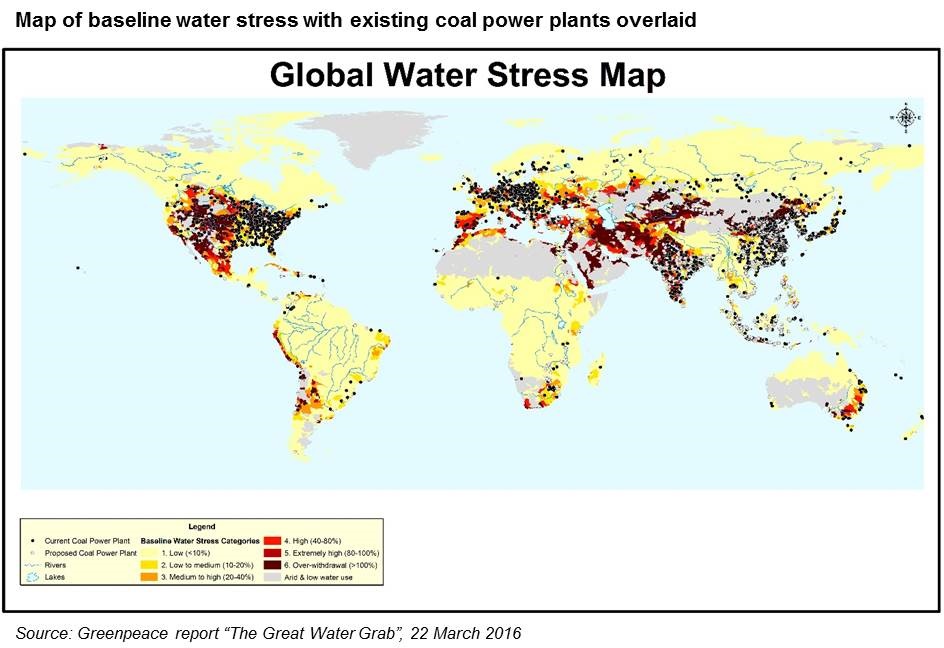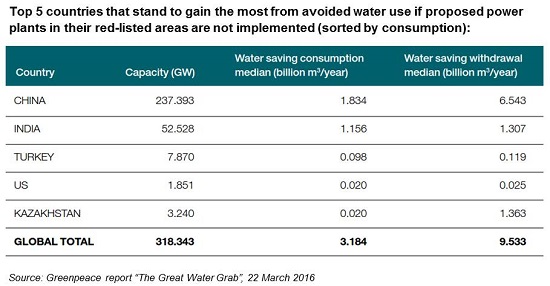The Complex Relationship and Looming Crisis Between Our Thirst For Water and Our Hunger for Energy
April 14th, 2016
Via China Water Risk, an interesting look at the water tension between global coal power plants and use of water for agriculture, industry, and cities:
Highlights
The
- 84% of global water consumption by the coal industry is from coal power plants, mostly from the cooling of power plants, hard coal and lignite mining is responsible for 16% of global water consumption.
- 44% of existing, and 45% of proposed coal power plants are located in areas categorised as high water stress, where water demand is high compared to available water resources, risking water conflicts and ecosystem impacts.
- A quarter of existing and proposed plants are located in over-withdrawal areas, which are using water resources faster than they are being replenished, basically risking running dry. Immediate change of energy policies are recommended in these areas.
- Significant water savings would be made by cancelling proposed coal plants and replacing existing plants with renewable energy in the red list areas. In countries with older power plant fleet, such as US, closing down old coal power plants older than 40 years would yield major savings. These measures would save enough water to meet the basic water needs of half a billion people.
The World Economic Forum has listed water security as one of the most tangible and fastest-growing social, political and economic challenges faced today. The high water intensity of global energy generation is creating a need for better analysis of water risks in power production. Greenpeace recently prepared two analyses on the water demand of coal, one looking at coal power plants globally another one analysing water impacts of coal power plants approved during 2015 in China. Key findings from these two reports are below.
The great water grab – how the coal industry is deepening global water crisis
“The Great Water Grab: How the Coal Industry is Deepening the Global Water Crisis” report models the impacts of world’s coal power plants on global water resources, analysing water demand of existing and proposed coal power capacity and its impacts on water stress of power plants.
This report is based on first of a kind global plant-by-plant analysis, prepared by Dutch water engineering consultancy Witteveen + Bos. Analysis of the impacts of coal power plants to fresh water resources was done using Aqueduct 2.1 water stress model developed by the World Resources Institue.1
The report results show that the world’s 8,359 existing coal power plants, totalling 1,811 GW of capacity are consuming 19 billion cubic meters of water annually. This amount could meet the basic water requirements of 1 billion people.2
The world’s 8,359 coal power plants water consumption is comparable to the basic water needs of 1 bn people
If the proposed coal power plant capacity of 1,300 GW came online, this would almost double water consumption to 37 billion cubic meters. For China the analysis shows water consumption of the existing coal power plant fleet to be 7.4 billion cubic meters per year.3
Analysis of the location of coal power plants and water resources shows that 45% of existing and 44% of the proposed coal power plants are in areas categorized as high water stress. Among them, a quarter are situated in areas, which are in over-withdrawal, using water supplies faster than they are replenished.
Over-withdrawal areas are risking running out of water or are forced to use water transfer schemes or groundwater. These regions will also have less resilience against extreme events like droughts, made worse by climate change. In a quarter of these over-withdrawal areas the water demand is five times bigger than water supply, using five years of worth of fresh water every year. 4
45% of existing & 44% of proposed coal power plants are in high water stress areas
1/4 of these are situated in areas which are using water supplies faster than they are replenished
Among the globally critical areas are Northern and Western China and Central India. Power utilities in these areas are often using more water efficient cooling technologies, which still use around 20 % of the amount water compared to most common cooling systems, while raising investment cost and lowering efficiency.5
“Inadequate water planning by regulators and investors in the investment phase can bring surprises…”
The regulatory environment is becoming tighter for utilities as there is competition for water with other major users such as agriculture or urban water users. Inadequate water planning by regulators and investors in the investment phase can bring surprises, utilities often seem not to be prepared for water shortages, which may in turn become an investment risk. Water scarcity, related to worse than expected drought, is already shutting down power plants in certain parts of India. 6
Report calls for immediate change of energy policies to avoid water crisis
The Water Grab report also outlines major water savings achieved by three policy measures:
- Stopping licensing of coal power plants in over-withdrawal areas;
- Phasing out existing coal power plants in over-withdrawal areas; and
- Retiring old coal power plants after 40 years of age.
It’s worth noting that replacing coal plants with low water footprint renewable energy, such as wind power and solar pv, can provides major water savings.
China can make significant water savings by cancelling proposed plants & even more by replacing existing plants with renewable energy
In countries like China and India, which are still expanding their coal power plant fleet, the avoided water consumption from cancelling proposed coal power plants in over-withdrawal areas would very significant, 1.83 billion cubic meters for China, and 1.16 billion cubic meters for India.
Even bigger water consumption savings come from phasing out existing power plants in over-withdrawal areas, with 3.4 billion cubic meters in China and 1.08 billion cubic meters in India.
Globally, because of the old coal power plant fleet, US stands to gain most water savings from retiring old coal power plants of over 40 years of age, in water stressed areas. In terms of withdrawal US would save 9.4 billion cubic meters of water, which accounts for 12 % of the national total withdrawal. Globally retiring older, less water efficient plants (16% of global capacity) can yield a huge 37% water saving in withdrawal globally, and 14% water savings in consumption. If all the water savings measures outlined in the report would be implemented, water consumption of 11 billion cubic meters would be saved, enough to meet the most basic water needs of half a billion people.
Greenpeace recommends countries to move into integrated water and energy planning
Greenpeace recommends countries to move into integrated water and energy planning, combining the analysis of existing water resources, their future development, changes is water demand from major users as well as the water necessary for the energy choices.
China’s coal power bubble – Major impacts on water
Greenpeace also did analysis of the water impacts of coal power plants planned in 2015 in the report “Is China doubling down on it’s coal power bubble”. Greenpeace analysed the 210 new coal projects being approved in China in 2015, totalling 169 GW of power capacity. 55 % of these power plants are located in areas with extremely high water stress, 5% in high water stress areas and 5 % in arid areas.
Water consumption by coal power plants would exacerbate conflict between urban, agricultural & industrial water use
Based on the information about planned cooling systems in the Environmental Impact Assessment, Greenpeace estimated that the water consumption of these coal power plants in the water stressed areas would be between 330 – 540 million cubic meters of water. This is equivalent to the needs of roughly 5-9 million urban dwellers or basic water needs of 18-30 million people7. This water consumption would exacerbate the conflict between urban, agricultural and industrial water use. Water risk would also increase risks for the operation of the power plants, especially during droughts.
Proposed capacity is heavily concentrated in the most water-scarce regions. Power plants located in areas categorized as having high or extremely high water stress or arid are using various cooling systems. 64% of these power plants are using air cooling, 27% water cooling and 9% are combined heat and power plants with various cooling methods. Even plants equipped with air cooling still consume significant amount of water, almost one quarter of the amount of water compared to typical coal plant with water cooling, mainly for scrubbing air pollution from smokestack emissions. Thus, despite the cooling choices the overall water consumption of these power plants would be high.8
This entry was posted on Thursday, April 14th, 2016 at 8:42 am and is filed under Uncategorized. You can follow any responses to this entry through the RSS 2.0 feed. You can leave a response, or trackback from your own site.
Leave a Reply
You must be logged in to post a comment.
Educated at Yale University (Bachelor of Arts - History) and Harvard (Master in Public Policy - International Development), Monty Simus has held a lifelong interest in environmental and conservation issues, primarily as they relate to freshwater scarcity, renewable energy, and national park policy. Working from a water-scarce base in Las Vegas with his wife and son, he is the founder of Water Politics, an organization dedicated to the identification and analysis of geopolitical water issues arising from the world’s growing and vast water deficits, and is also a co-founder of SmartMarkets, an eco-preneurial venture that applies web 2.0 technology and online social networking innovations to motivate energy & water conservation. He previously worked for an independent power producer in Central Asia; co-authored an article appearing in the Summer 2010 issue of the Tulane Environmental Law Journal, titled: “The Water Ethic: The Inexorable Birth Of A Certain Alienable Right”; and authored an article appearing in the inaugural issue of Johns Hopkins University's Global Water Magazine in July 2010 titled: “H2Own: The Water Ethic and an Equitable Market for the Exchange of Individual Water Efficiency Credits.”



